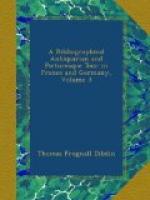M. Koch had been, if he be not yet, a grocer; but was so fond of rare old books, that he scarcely ever visited his canisters and sugar-loaves. I bought some very curious little pieces of him, to the amount of ten or twelve guineas: among which, was the strange and excessively rare tract, in Latin and German, entitled De Fide Concubinarum in Sacerdotes, of which a very particular account appears in the Bibliographical Decameron, vol. i. p. 229, 235. His simplicity of manners and friendliness of disposition were equally attractive; and I believe if he had possessed the most precious Aldine Classics, upon vellum, I could have succeeded in tempting him to part with them.
The town of Manheim is large, neat, and populous; containing 20,000 souls. The streets run generally at right angles, and are sufficiently airy and wide. But, compared with the domestic architecture of Augsburg, Munich, and Vienna, the houses are low, small, and unornamented. The whole place has much the appearance of a handsome provincial town in England. There are gardens and public walks; but the chief of these is connected with the old red-stone palace of the former Elector Palatine. The Rhine terminates these walks on one side; and when I visited them, which was twice during my stay, that river was running with a rapid and discoloured current. The Rhine is broad here; but its banks are tame. A mound is raised against it, in some parts, to prevent partial overflows, and a fine terrace crowns its summits. A bridge of boats, over which you pass into France, is immediately in view. Upon the whole, these gardens, which seem to be laid out in the English fashion, and which are occasionally varied by some pleasing serpentine walks, are left in a sad state of neglect. The breeze from the river plays freely along the osiers and willows, with which its banks are plentifully planted; and I generally felt refreshed by half an hour’s walk upon the broad, dry, gravel terrace, which comes close up to the very windows of the palace. The palace itself is of an enormous size—but is now bereft of every insignia of royalty. It is chiefly (as I understood) a depot for arms.




